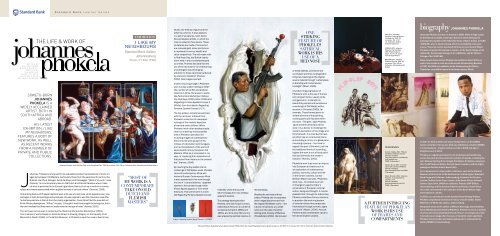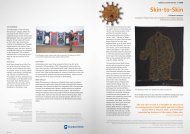Download PDF (900kb) - Standard Bank Arts
Download PDF (900kb) - Standard Bank Arts
Download PDF (900kb) - Standard Bank Arts
- No tags were found...
Create successful ePaper yourself
Turn your PDF publications into a flip-book with our unique Google optimized e-Paper software.
<strong>Standard</strong> <strong>Bank</strong> Learner SeriesjohannesTHE LIFE & WORK OFW R I T T E N B YP H I L I P PA H O B B S& EMILE MAURICE.C O M P I L E D B YT H E H E R I TA G EA G E N C Y C C , W I T HA S S I S TA N C E F R O MNHLANHLA NGWENYASOWETO-BORNJOHANNESPHOKELA IS AWIDELY ACCLAIMEDARTIST, BOTH INSOUTH AFRICA ANDABROAD.HIS LATESTEXHIBITION, I LIKEMY NEIGHBOURS,FEATURES A BODY OFNEW WORK, AS WELLAS RECENT WORKSFROM A NUMBER OFPRIVATE AND PUBLICCOLLECTIONS.Johannes Phokela, As the Old Ones Sing, so the Young Ones Pipe, 1998. Oil on canvas, 160 x 198 cm. Collection: Iziko South African National GalleryJohannes Phokela is renowned for his exquisitely painted manipulations of iconic imagesby European Old Masters, particularly those from the seventeenth century, likeRubens, Van Dyck, Breugel, Jacob de Gheyn and Caravaggio. “Most of my work,” saysPhokela, “is a contemporary take on Old Dutch and Flemish Masters where I takeon what is perceived to be Europe’s grandiose history of art as a medium to conveyvalues and ideals represented within a global context of cultural elitism” (Dlamini, 2006).One striking feature of Phokela’s satirical work is his use of a red nose, which appears every nowand again in both his paintings and sculptures. He was inspired to use this clown-like nose afterhe had acquired one in the UK from the charity organisation, Comic Relief. But the nose did notfit his African physiognomy. “At first,” he says, “I thought I must have bought the wrong size, but inthe end I realised that they were not really made for my type of nose” (Haines, 2002).The red nose can be seen in works like the theatrical Pantomime Mortal Quiz (2001),from a series of works based on Jacob de Gheyn’s drawing, Allegory on the Equality of allMankind in Death (1599), in the British Museum. In Phokela’s work the nose is fi xed to twoEXHIBITIONI LIKE MYNEIGHBOURSphokela<strong>Standard</strong> <strong>Bank</strong> GalleryJohannesburg3 Feb–21 Mar 2009“MOST OFMY WORK IS ACONTEMPORARYTAKE ON OLDDUTCH ANDFLEMISHMASTERS”skulls, one held by a fi gure and theother by a cherub. It also appearsin a set of sculptures, Gold, Silver,Bronze Medals (2008), in which thenose is nailed to three skulls. Thesesculptures are made of bronze butare coloured gold, silver and bronzeto represent currency, wealth andvalue respectively. The red noses referto Red Nose Day, the British charityevent held in aid of underdevelopedcountries. Phokela has said that theuse of the red nose is “an entertainingand divergent way of bringingattention to those countries burdenedby economic hardship” (Haines,2002). See images overleaf.Another recurring image in Phokela’swork is a boy soldier holding an AK47rifl e, symbol of confl ict and politicalviolence in Africa. He is seen in workslike Pantomime Mortal Quiz (Yellow),Flip Flop Boys (2005), Alien (2006) andRegarding Fontana Spatial Concept II(White), from the triptych, RegardingFontana: Spatial Concept I, II, III.The boy soldier, sometimes adornedwith the red nose, is drawn fromPhokela’s collection of newspapercuttings of the media’s depictionof war and slave children. WhilePhokela’s work often evades simple,clear-cut meaning, the boy soldiertells of Phokela’s penchant forincluding images of contemporaryAfrica into his work as part of hiscritique of colonialism and its legacy,and re-interpretation of the works ofseventeenth-century European OldMasters. What he is interested in, hesays, is “exploring the implications ofthat period from history on the presentday” (Haines, 2006).By inserting the boy soldier into hisrenderings of Old Master works, Phokelaconnects contemporary Africa withhistorical Europe. Contemporary Africais also represented in his work throughthe use of “cuts and stitches,” apparentslashes in the canvas through whichAfrican figures appear, or from whichthey burst. This can be seen in a worklike Regarding Fontana Spatial ConceptTriptych, Regarding Fontana: Spatial Concept I, II, III (2005)II (White), where the boy withAK47 emerges from one of theseapparent slashes.This strategy developed afterPhokela, who was living in London,visited South Africa on a number ofoccasions during the 1980s and1990s, at a time when the countrywas wracked by political violence inthe townships.Besides the red nose and boysoldier, Phokela also incorporatesother images disconnected fromthe original Old Master works – likea bunch of bananas, or a creditcard, as in the case of anotherstriking work, Ecstasy of Medusa(Trustafarian) (2002). His inclusionONESTRIKINGFEATURE OFPHOKELA’SSATIRICALWORK IS HISUSE OF ARED NOSEof these oddities, all of which areout of place and time, is designed tobring new meanings to the originalsource material through “a shamelessre-branding with contemporaryhindsight” (Maart, 2006).A further intriguing feature ofPhokela’s work is his use of framesand compartments, usually whiteand geometric, to disrupt hisbeautifully painted and sumptuousre-workings of Old Master works,as seen in Chocolat (2005), forexample. These frames serve toisolate sections of the painting,creating particular focuses withinthe work. “The grid,” says Phokela,“gives another dimension to thework; it is a device to challenge theviewer’s perception of the image andform beneath. It is intended to havean effect like an ornamental framesurrounding a mirror, or a glass panemounting a picture… You have toregard it as part of the work, just likethe traditional frame of a painting…It gives the work a sort of focal pointthat can stimulate the viewer’sreaction” (Haines, 2002).Phokela’s work is as much an inquiryinto European art history as it isan exploration of contemporarypolitics, economy, culture and lifein the former colonies. CuratorBrenton Maart has said, “Phokela’swork may… be viewed as an actof insurgency against today’sremainders of European colonialaction, being and thought. It may bepossible that, through his references,Phokela underlines his key intention:to question the enduring systemof colonial values that perpetuatethemselves through symbols, signsand icons” (Maart, 2006). As such,Phokela adds considerable value tothe decolonisation project.TOP LEFT: JohannesPhokela, Ecstasy of Medusa(Trustafarian), 2002. Oilon canvas, 152 x 122cm. Collection: GordonSchachat CollectionMIDDLE LEFT: JohannesPhokela, Flip Flop Boys,2005. Mixed media onpaper, 90 x 71 cm. Collection:Dr Oupa MorareBOTTOM LEFT: JohannesPhokela, Chocolat, 2005. Oilon canvas, 198 x 168 cm.Collection: Johannesburg ArtGalleryREFERENCESDlamini, Ndaba. 2006. ‘Phokelaexhibition celebrates mentor’.[Online]. Available:http://joburgnews.co.za/2006/july/jul28_phokela.stm[2008, 15 December]Haines, Bruce. 2002. ‘In Conversationwith Johannes Phokela’.[Online]. Available:www.simonmeefineart.com [2008,2 December]Maart, Brenton. 2006. ‘JohannesPhokela’. In Art South Africa,volume 4, no 3.[Online]. Available:www.artsouthafrica.com/?=91[2008, 2 December]A FURTHER INTRIGUINGFEATURE OF PHOKELA’SWORK IS HIS USEOF FRAMES ANDCOMPARTMENTSbiographyJOHANNES PHOKELAJohannes Phokela was born in Soweto in 1966. While in high schoolhe attended art classes at the Open School in Johannesburg. Hesubsequently studied at the Federated Union of Black Artists, or FUBA(1983-86), also in Johannesburg, where he completed a two-yearcourse. There his mentor was South African art icon, Durant Sihlali.Phokela completed his studies in London, at the Royal College of Art(1991-93); Camberwell College of Art (1988-91); and St. Martin’sCollege of Art (1987-88).Since rising to fame abroad, Phokela has exhibited in South Africa onquite a few occasions, such as on the second Johannesburg Biennalein 1997. His 2006 solo exhibition at the Johannesburg Art Gallery,Translation, was held in honour of his former mentor, Sihlali.In 2007 he held another solo show, Compendium, at the KZNSAGallery in Durban. He has also held solo exhibitions at Gallery MOMOin Johannesburg – Imagine where you’ll be in 2005 and Age ofEnlightenment in 2003.Phokela is a regular participant in art workshops and residenciesacross the world and has received a number of awards, including theJohn Moores Painting Prize through the Walker Art Gallery (Liverpool,UK), the BP National Gallery Portrait Award (London), and the highlyprestigious Decibel Artist’s Award (UK).He is represented in major public collections, such as the NationalMuseum of African Art at the Smithsonian in Washington; <strong>Standard</strong><strong>Bank</strong> Corporate Collection, Johannesburg; Gasworks Art Studios,London; Delfino Studio Trust, London; Iziko South African NationalGallery, Cape Town; UNISA art collection, Pretoria; BHP Billiton,Johannesburg; and the Gordon Schachat Collection, South Africa.He is also represented in the collection of the South African HighCommission in London.In 2006, as a contribution to the Sunday Times Heritage Project,Phokela completed a memorial in honour of youth leader, TsietsiMashinini, in White City, Jabavu, Johannesburg.Along with artists of the calibre of William Kentridge, David Golblatt,Santu Mofokeng and Zwelethu Mthethwa, Phokela is one of a numberof artists who have spearheaded South Africa’s re-emergence on theinternational art stage after the years of isolation under apartheid.Phokela lives in London and Johannesburg and is represented byGallery MOMO in Johannesburg.Johannes Phokela, Regarding Fontana Spatial Concept II (White) (from the triptych Regarding Fontana: Spatial Concept I, II, III), 2005. Oil on canvas, 165 x 130 cm. Collection: Gordon Schachat Collection








